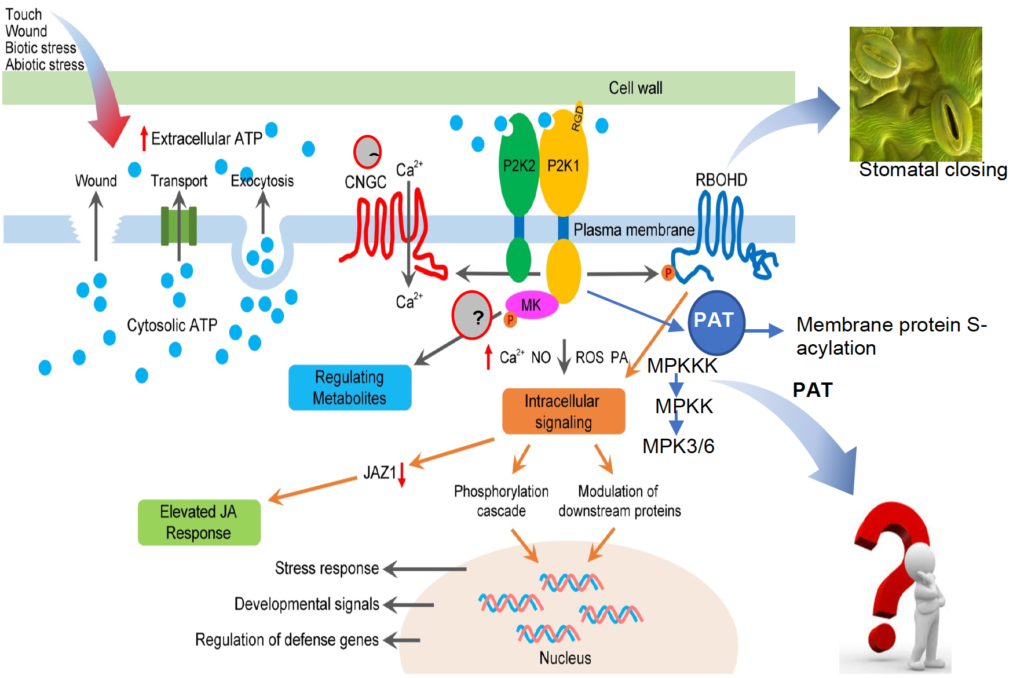Postdoctoral position, Purinergic signaling in plants, available immediately, University of Missouri
Description: A postdoctoral position is available for a NIH/NSF-funded project to explore the role of purinergic signaling in in plants. Purinergic signaling, although not extensively studied in plants, affects a wide range of plant processes, including those associated with the plant response to abiotic and biotic stress. The project will involve further studies of the mechanisms by which the P2K1 (DORN1) and P2K2 receptors recognize extracellular ATP and induces downstream signaling, as well as characterization of various Arabidopsis mutants defective in purinergic signaling. The work involves a variety of functional genomic and biochemical methods to elucidate the molecular mechanisms involved in plant purinergic signaling. Experience with modern molecular and biochemical methods (e.g., those involved in protein isolation, protein characterization and protein complex formation are essential). Candidates that do not have a strong track record of achievement and who do not have the requisite biochemical skills are strongly discouraged from applying.
The successful candidate will join a team of other postdoctoral associates, graduate students and undergraduates exploring plant purinergic signaling in the laboratory. Prior experience in advanced methods in biochemistry is essential for the project. Prior experience in any of the following areas: protein biochemistry, proteomics, protein-protein interactions, protein covalent modification, site-directed mutagenesis, protein expression, mass spectrometry and bioinformatics is highly desirable. Applicants should possess a Ph.D. degree in Biochemistry, Biology or Molecular Biology and have a strong interest in plant cellular signaling. Excellent oral and written communication skills and the ability to work well in a collaborative research environment are essential. The successful candidate is expected to have demonstrated an impressive record of achievement and excellence.
Competitive salary (beginning at $47,500), fringe benefits including health insurance, retirement, and travel support to meetings are available for this position. Funding for this project is renewable for a period of three years based on performance.
Application Instructions: Please email a cover letter outlining your suitability for the position, list of references with contact information and recent CV to Gary Stacey at staceyg@missouri.edu.
The University of Missouri is an equal opportunity employer.

Purinergic signaling in plants:
ATP is a ubiquitous compound in all living cells; it not only provides the energy to drive many biochemical reactions, but also functions in signal transduction as a substrate for kinases, adenylate cyclases, etc. However, ATP was also shown to be an essential signaling agent outside of cells, where it is referred to as extracellular ATP (eATP). An extensive literature exists in animals implicating eATP in numerous cellular processes, including neurotransmission, immune responses, cell growth, and cell death. Initial observations of effects of eATP in animals were met with considerable skepticism. However, this changed when the plasma membrane-localized receptors, purinoceptors of the P2X and P2Y classes, were identified and shown to mediate the effects of eATP.
In contrast, relatively little has been done to examine the role of eATP in plants. However, over the past several years, eATP has been implicated in a variety of plant processes, including root-hair growth, stress responses, gravitropism, cell viability, pathogen responses and thigmotropism. A significant break through in the study of purinergic signaling (eATP response) in plants was our identification of the first, plant eATP receptor (Choi et al., 2014). DORN1 is a lectin receptor-like kinase and, therefore, identifies a new family of purinoreceptors (P2K).
The laboratory is continuing our characterization of P2K1 (DORN1) and other proteins involved in eATP recognition, as well as exploring the role that eATP signaling plays in plant growth and development. Our findings clearly implicate purinergic signaling in a variety of key plant processes suggesting that eATP is just as important and interesting in plants as it is in animals (including humans).
Selected, publications from the lab on this topic:
Pham et al. 2020. P2K2 is a second plant receptor for extracellular ATP and contributes to innate immunity. Plant Physiol. 183 (3) 1364-1375; DOI: 10.1104/pp.19.01265
Matthus et al. 2019. DORN1/P2K1 and purino-calcium signalling in plants; making waves with extracellular ATP. Ann. Bot. https://doi.org/10.17863/CAM.42662
Chen et al. 2019. S-Acylation of plant immune receptors mediates immune signaling in plasma membrane nanodomains BioRxiv https://doi.org/10.1101/720482 270.
Chen et al. (2017) Extracellular ATP elicits DORN1-mediated RBOHD phosphorylation to regulate stomatal aperture. Nature Commun. 8: 2265. doi:10.1038/s41467-017-02340-3255.
Tripathi et al. (2017) Extracellular ATP acts on jasmonate signaling to reinforce plant defense. Plant Physiol. 176: 511–523. https://doi.org/10.1104/pp.17.01477
Cao et al. (2014) Extracellular ATP is a central signaling molecule in plant stress responses. Curr. Op. Plant Biol. 20: 82-87. https://doi.org/10.1016/j.pbi.2014.04.009
Choi et al. (2014) Identification of a plant receptor for extracellular ATP. Science Vol. 343 no. 6168 pp. 290-294. DOI: 10.1126/science.343.6168.290

